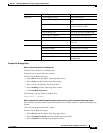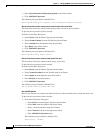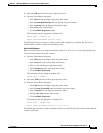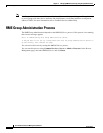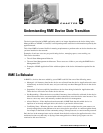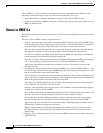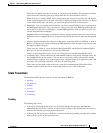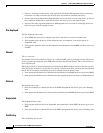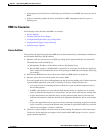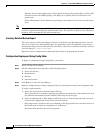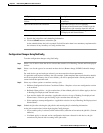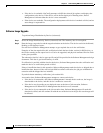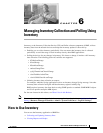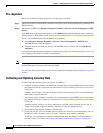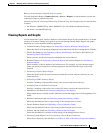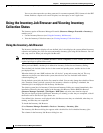
5-5
User Guide for Resource Manager Essentials 4.1
OL-11714-01
Chapter 5 Understanding RME Device State Transition
States in RME 4.x
• If the operator picks the device in Conflicting state and deletes it from RME, the device goes out of
RME.
• If the user manually updates the device credentials for RME management, the device goes to
Pending state.
RME 4.x Scenarios
The following section describes the RME 4.x scenarios:
• Device Addition
• Inventory Detailed Device Report
• Configuration Deployment Using Config Editor
• Configuration Changes Using NetConfig
• Software Image Upgrade
Device Addition
This describes the application task where RME does not have the automatic synchronization with Device
and Credential Repository (DCR) enabled.
1. Operator adds one or more devices to DCR, providing all the required attributes and credentials.
The mandatory fields from DCR are:
a. Management IP address or Host Name or Device ID, Display Name.
b. Device MDF category or SysObjectID is expected to be valid value for the Device Type field.
This is required to instantiate the correct device package for RME jobs (for example, NetConfig
job creation).
2. DCR informs RME that new devices have been added, and RME updates its picker list.
3. Operator selects devices from the picker list to add to RME.
For each selected device, Device Management puts the device into pending state. It then invokes the
registered RME application tasks such as Inventory Collection, Config Collection etc.
–
If no task succeeds in contacting the device, the device is put into the Pre-deployed state by
Device Management.
–
If RME’s alias detection is successful and finds that this device is a duplicate of an existing
device in either the Pre-deployed or Normal states, the new device is put into the Aliased state.
–
If alias detection does not mark this device as being Aliased (either because it did not have
sufficient information to make the decision or the algorithm identifies the device to be unique)
and
–
If any of the application tasks in step 4 succeed in contacting (exchanging any packets) with the
device, the device is moved to the Normal state. Note that no application task has to succeed in
order for this to happen – Contact is sufficient.
4. The device selector displays all devices that are in the Pending, Pre-deployed, and Normal states.
The devices in Pre-deployed state appear in the system-defined MDF groups as well as a special
group called Pre-deployed.



